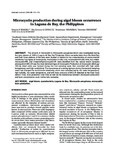Residence time models and Pyrodinium blooms in Matarinao and Murcielagos Bays, Philippines
- Global styles
- MLA
- Vancouver
- Elsevier - Harvard
- APA
- Help

Download URL
philjournalsci.dost.gov.phDate
2022-03Author
Page views
567ASFA keyword
Taxonomic term
Geographic names
Metadata
Perlihat publikasi penuh
Share
Abstract
This is the first report on hydrodynamic models to determine current and water residence time patterns for Matarinao and Murcielagos bays in the Philippines, which have a long history of harmful algal blooms (HABs). Field surveys were conducted in Matarinao Bay in April and August 2010 and in Murcielagos Bay in February 2011. Hydrodynamic models of the bays were developed, and spatially explicit water residence times were estimated from the models based on rates of concentration decrease of a tracer within the bay. Both bays exhibited two distinct areas – the mouth with faster current flow and low residence time, and the head area with slower current flow and higher residence time. During the southwest monsoon, the residence time at Matarinao Bay was 5 d longer than that during the northeast monsoon. Phytoplankton sampling in both bays confirmed blooms of Pyrodinium bahamense, but the spatial distribution did not consistently correlate with the simulated residence time patterns. While residence time plays a significant role in algal blooms, extraneous factors may also influence the distribution of phytoplankton within embayments.
Suggested Citation
Lumayno, S. D. P., Benico, G., Yñiguez, A., Alabia, I. D., Fernandez, I. Q. D. G., Dianala, R. D. B., Azanza, R., & Villanoy, C. (2022). Residence time models and Pyrodinium blooms in Matarinao and Murcielagos Bays, Philippines. Philippine Journal of Science , 151(S1), 79-90. http://hdl.handle.net/10862/6296
Type
ArticleISSN
0031-7683Koleksi
- Journal Articles [1258]
Related items
Showing items related by title, author, creator and subject.
-
Incidence and causes of mass fish kill in a shallow tropical eutrophic lake (Laguna de Bay, Philippines)
Cuvin-Aralar, Maria Lourdes; Santiago, Alejandro E.; Gonzal, Angelito C.; Santiago, Corazon B.; Romana-Eguia, Maria Rowena ; Baldia, Susana F.; Palisoc Jr., Fermin (Shiga Prefectural Government, 2001)
Mass fish kills in Laguna de Bay, the largest lake in the Philippines, has been reported as early as in the 1930’s. With the introduction of and development of aquaculture in this lake, considerable attention and concern ...
; Baldia, Susana F.; Palisoc Jr., Fermin (Shiga Prefectural Government, 2001)
Mass fish kills in Laguna de Bay, the largest lake in the Philippines, has been reported as early as in the 1930’s. With the introduction of and development of aquaculture in this lake, considerable attention and concern ... -
Microcystin production during algal bloom occurrence in Laguna de Bay, the Philippines
Baldia, Susana F.; Conaco, Ma. Cecilia G.; Nishijima, Toshitaka; Imanishi, Susumu; Harada, Ken-Ichi (Japanese Society of Fisheries Science, 2003)The amount of microcystin in Microcystis aeruginosa bloom was investigated during the rainy season of 1999 in Laguna de Bay, the Philippines. Bloom samples taken from the West Bay and East Cove stations of the lake were ... -
Paralytic shellfish poisoning toxin accumulation in shellfishes collected from various habitats in Murcielagos Bay, Philippines during harmful algal blooms occurrence
Narceda, Ronald Jefferson A.; Montojo, Ulysses M.; Eguia, Ma. Rowena R. ; Sia Su, Glenn L. (American-Eurasian Network for Scientific Information (AENSI), 2014)
This study aims to determine whether the habitat of bivalves plays an influence in the occurrence of tropical shellfish toxicity during toxic red tide bloom occurrences in Murcielagos Bay, Misamis Occidental, Philippines. ...
; Sia Su, Glenn L. (American-Eurasian Network for Scientific Information (AENSI), 2014)
This study aims to determine whether the habitat of bivalves plays an influence in the occurrence of tropical shellfish toxicity during toxic red tide bloom occurrences in Murcielagos Bay, Misamis Occidental, Philippines. ...






